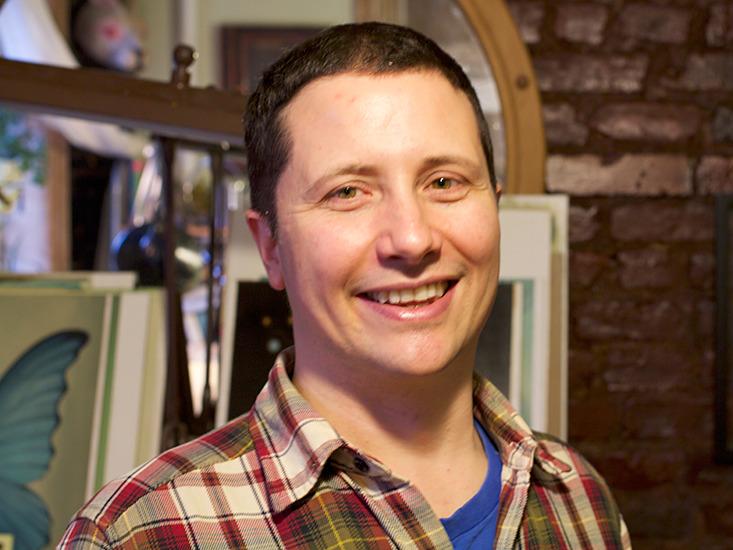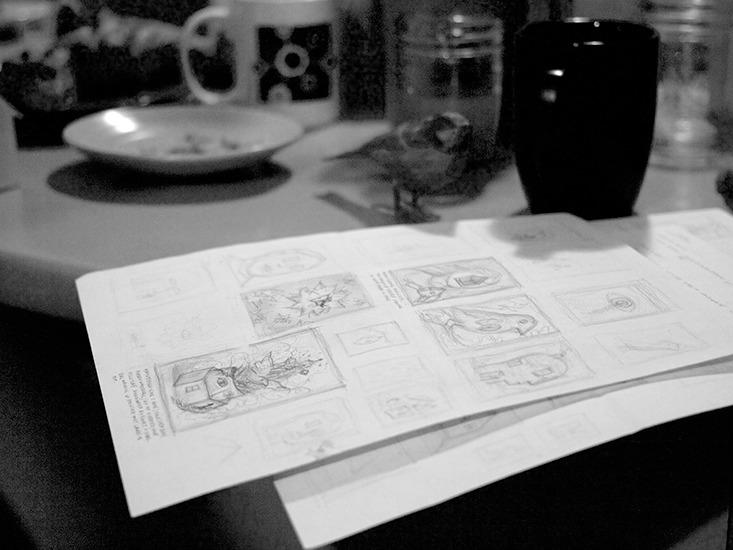By now, you’ve likely noticed that we here at Nautilus care a great deal about imagery. Whether it’s our quarterly print edition or our weekly online chapters, the images that accompany each piece are crafted with care. But have you ever wondered where the images you see each week come from, and how they’re made? To give you a behind-the-scenes look, Nautilus’s art director, Len Small, visited this month’s featured artist, Chris Buzelli, in his home studio in Manhattan’s East Village.
Buzelli grew up in South Chicago, visiting his grandfather’s television-repair shop, where he would set himself in front of rows of televisions and watch his favorite cartoons. It was here that he discovered the Bill Alexander show, who was a predecessor to the infamous Bob Ross. But Buzelli’s work is hardly just happy clouds. His paintings appear like lucid dreams, where the beak of a bird or a perfectly cracked vase sit on the same landscape as our solar system and a giant butterfly. Along with his illustration work, Chris also teaches at the Rhode Island School of Design and School of Visual Arts.

We asked our readers what they wanted to know about the art from this chapter—and here, Buzelli answers their questions.
What do you want out of a science visual? Is there something you look for when you try to visualize science?
You don’t want it to be over-literal and educational-looking, because we’ve gotten that in grade-school books. Even though some of those images are really beautiful and I used a few as references for this project. I use some of those references in these pieces. In the planet one, I was thinking back to my old grade-school textbooks. I want that piece of art to work for the story, and to accentuate the story, but not actually tell the same story. Otherwise, why bother?
How did you decide to handle this issue’s theme of Home?
At first I thought I could put an aspect of a house in all of these images. It wouldn’t always have to be a house; it could be a window, a door. But pretty soon I found you guys wanted to push it, so there’s no hints of a house or a home in most of the images. I was so happy you said that, but it also freaked me out!

How much research do you do for each piece?
It really depends on the type of project and topic. For topics that I’m familiar with, I probably spend a few hours doing research. And for others, I can spend a few days. This usually consists of distilling the article, doing some background research, digging around my library collection and then trying to find the most effective way to visually illustrate the article.

How do you come up with the idea? Do you see it in your mind formed, or does it blossom as you go?
I wish the idea would just come to me immediately. That would make life so much easier. However, it is like all jobs and takes some work, hours and banging my head on my desk. After the initial research, it takes a bit of time to figure out at least three different and effective visual options to send to the art director. I’ll sometimes sketch about 20–30 rough ideas before I come up with a few that are not only good visual solutions for the article but also communicate on their own as well.

How long does each piece take to complete? What are the stages of working on a piece?
Once again it really depends on the project. Some jobs are due the same day for clients like The New York Times op-ed section. And advertising jobs can take about a month. My process usually starts by distilling the article down to a sentence or two. If I need to understand the topic more, I’ll do some background research. Then I’ll start sketching out thumbnail-sized sketches of anything that comes to mind. At this point it’s not about coming up with a perfect solution, but more about creating a visual library for this particular article. I’ll then go back over my thumbnails and see if any of them are successful. Sometimes I’ll get lucky and few will work, sometimes by combining certain elements, and sometimes these visual ideas will lead to other successful ideas. The top three ideas will be sent to the art director.
Once the final sketch is chosen, I’ll start composing, revising and crafting the drawing on a gessoed masonite board. After that the most time-consuming part starts—the color studies and the final oil painting. I usually spend about 30 to 70 hours on this process.
What’s the hardest part about creating artwork for Nautilus? Which painting for us was the most difficult, and which was the easiest?
The difficult part is trying to figure out a visual solution for the articles that not only solve the conceptual puzzle but also speak to a much wider audience as well. The most difficult part of this project was for the cover. It was a challenge because it had to sum up all the articles about “Home” and at the same time be the cover image. This image couldn’t be a generic summation but needed to have a strong singular iconic message. I think we went through about five rounds of sketches before finally coming up with the “bird universe” image.

The easiest was the “planets in a vase” painting for the article, “Madness of the Planets.” I’ve always wanted to do a painting of the planets but with a twist. I remember, as a kid, poring over any science book with illustrations of the planets and outer space. I tried to add a bit of that nostalgic and magical element to the piece.
What do you do with the paintings once you’re done with them?
My paintings are all oil on board. Some of them get bought by readers, fans, patrons, art directors, or editors. I have a few galleries around the U.S. that also show my work. I keep a few of my favorites as well. And some get painted over if I’m not happy with them.
Len Small is Nautilus’ art director. Rose Eveleth is Nautilus’ special media manager.






























